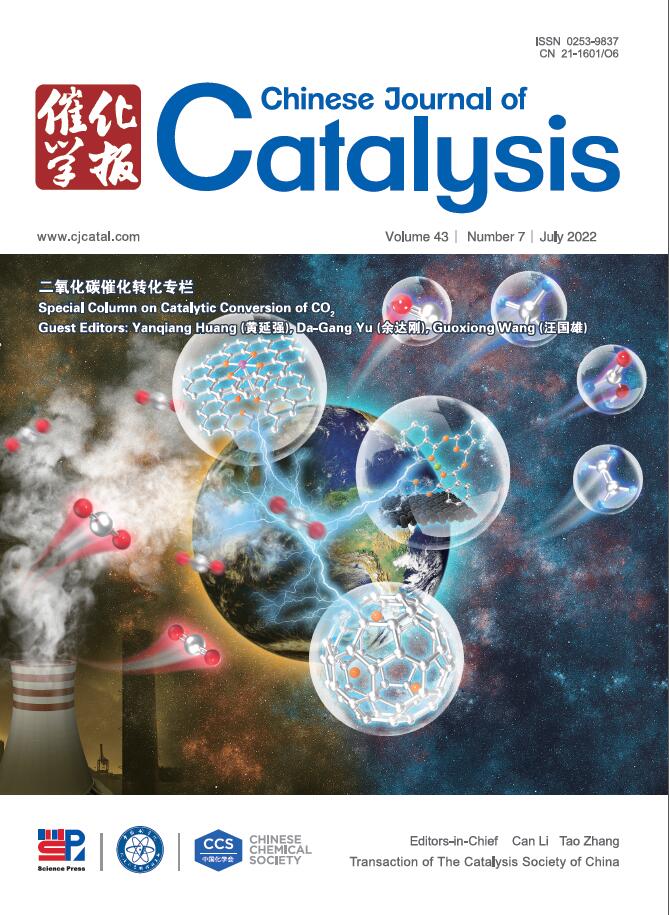构建双助催化剂定向可量化的电子和空穴转移以增强光催化性能
IF 17.7
1区 化学
Q1 CHEMISTRY, APPLIED
引用次数: 0
摘要
光催化剂是通过可见光催化制备精细化工和生物医药中间体所必需的,但现有光催化剂催化效率低,限制了其广泛应用。通过在CdS纳米颗粒上锚定具有电子吸引能力的还原助催化剂Ti3C2Tx和具有空穴捕获能力的氧化助催化剂2-巯基苯并咪唑(MBI),成功制备了CdS/Ti3C2Tx/MBI纳米复合材料。CdS/Ti3C2Tx/MBI纳米复合材料的Ti3C2Tx和MBI可以分别从CdS纳米粒子中提取电子和空穴,实现电子空穴分离。此外,CdS/Ti3C2Tx/MBI纳米复合材料的电子吸引和空穴捕获能力取决于Ti3C2Tx和MBI的含量,而可量化的电子和空穴转移最终决定了CdS/Ti3C2Tx/MBI纳米复合材料的光催化效率。CdS/Ti3C2Tx/MBI纳米复合材料的瞬态光电流密度是CdS纳米材料的6倍。CdS/Ti3C2Tx/MBI纳米复合材料具有较强的电子空穴分离能力,具有优异的可见光催化有机转化性能。CdS/Ti3C2Tx/MBI纳米复合材料的产率为~96% (~8000 μmol·g-1·h-1),是CdS纳米复合材料产率(~2500 μmol·g-1·h-1, 30%)的3倍。这项工作为构建高效稳定的光催化剂提供了一种新的策略,可以用于高效的可见光驱动有机转化。本文章由计算机程序翻译,如有差异,请以英文原文为准。
Constructing dual-cocatalyst-directed quantifiable electron and hole transfer for enhanced photocatalytic performance
Photocatalysts are essential for the preparation of wanted fine chemical and biomedical intermediates via visible photocatalysis, but existing photocatalysts with low catalytic efficiency limit their wide applications. Herein, CdS/Ti3C2Tx/MBI nanocomposites have been successfully fabricated through anchoring reduction cocatalyst Ti3C2Tx with electron-drawing ability and oxidation cocatalyst 2-mercaptobenzimidazole (MBI) with hole-capturing capacity on CdS nanoparticles. The Ti3C2Tx and MBI of CdS/Ti3C2Tx/MBI nanocomposites can extract electrons and holes from CdS nanoparticles to come true electron-hole separation, respectively. Moreover, the electron-drawing and hole-capturing abilities of the CdS/Ti3C2Tx/MBI nanocomposites depend on Ti3C2Tx and MBI contents, and the quantifiable electron and hole transfers finally determine photocatalytic efficiency of the CdS/Ti3C2Tx/MBI nanocomposites. The transient photocurrent density of the CdS/Ti3C2Tx/MBI nanocomposites is 6-fold higher than that of the CdS nanoparticles. The CdS/Ti3C2Tx/MBI nanocomposites with strong electron-hole separation capability exhibit outstanding visible photocatalytic organic transformation properties. The CdS/Ti3C2Tx/MBI nanocomposites produce (E)-N-benzyl-1-phenylmethylimine in ~96% yield (~8000 μmol·g–1·h–1), which is 3-fold higher than the CdS nanoparticles (~2500 μmol·g–1·h–1, 30%). This work provides a new strategy for constructing efficient and stable photocatalysts that can be used for efficient visible light-driven organic transformations.
求助全文
通过发布文献求助,成功后即可免费获取论文全文。
去求助
来源期刊

Chinese Journal of Catalysis
工程技术-工程:化工
CiteScore
25.80
自引率
10.30%
发文量
235
审稿时长
1.2 months
期刊介绍:
The journal covers a broad scope, encompassing new trends in catalysis for applications in energy production, environmental protection, and the preparation of materials, petroleum chemicals, and fine chemicals. It explores the scientific foundation for preparing and activating catalysts of commercial interest, emphasizing representative models.The focus includes spectroscopic methods for structural characterization, especially in situ techniques, as well as new theoretical methods with practical impact in catalysis and catalytic reactions.The journal delves into the relationship between homogeneous and heterogeneous catalysis and includes theoretical studies on the structure and reactivity of catalysts.Additionally, contributions on photocatalysis, biocatalysis, surface science, and catalysis-related chemical kinetics are welcomed.
 求助内容:
求助内容: 应助结果提醒方式:
应助结果提醒方式:


